
By Train from Tangier to Meknès
My Trip to Meknès
I would take the high-speed Al Boraq
down the coast from Tangier as far as Kenitra.
There I would change to a normal train running inland
through Sidi Slimane and Sidi Kassem to Meknès.
I opted for a first-class ticket,
which was well worth the slight increase in price
on the excellent Moroccan railroad.
My ticket was just 266 dh.
I purchased my ticket when I first arrive in Tangier,
as the Tangier Ville station is about three kilometers
from the medina.
I told the woman at the ticket office that I wanted to go to
Meknès on a certain day.
She asked me what time and I said "Vers midi,"
around noon, because I didn't know how often
trains ran on the second segment.
There was a train every hour on both segments,
so my ticket was for précisément 12:00.
I'm used to living in a place with only three trains a week.
Taking an ordinary train the whole way would have taken
me inland to Sidi Kassem and then on to Meknès.
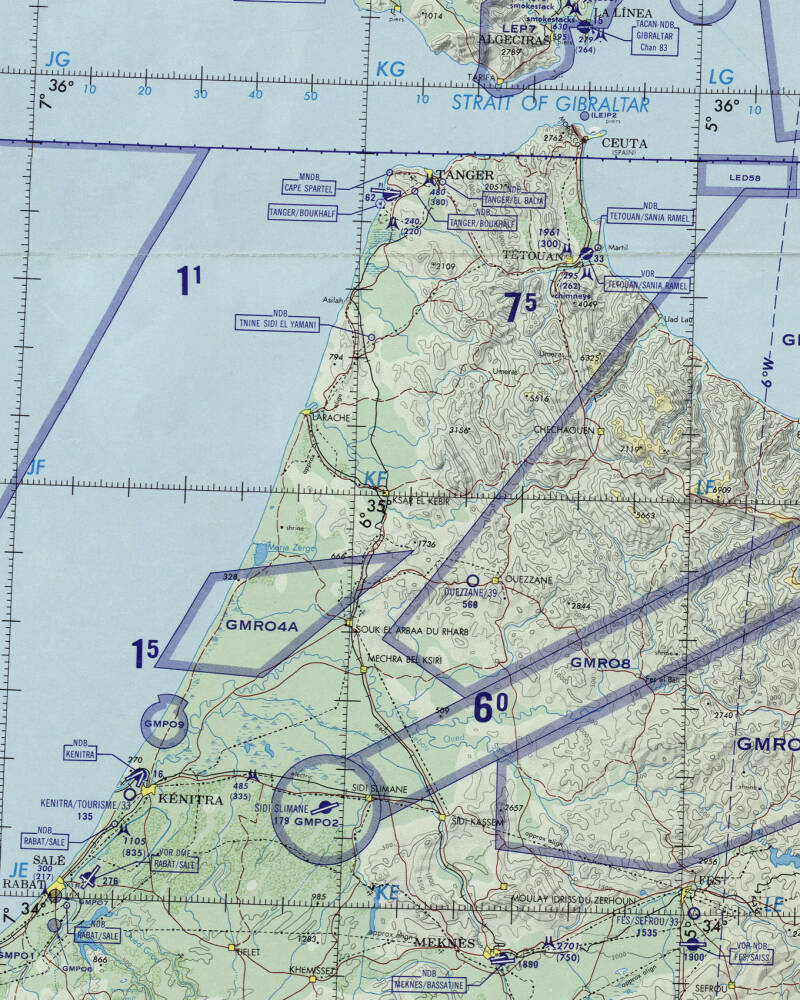
Portion of Operational Navigational Chart G-1 from the Perry-Castañeda Library Map Collection at the University of Texas at Austin.
To Gare Tangier Ville
I took a petit taxi from the Grand Socco to Tangier Ville station, bought my ticket, and went into the Al Boraq Lounge. The woman at the reception desk checked my ticket and asked me "Ça va?" and I told her that I was doing very well indeed. Wow, this was nice. Comfortable armchairs and complementary tea, soft drinks, and mineral water. The other side of the lounge opens directly onto the platforms.
I had started the trip from where I live, within walking distance of a station on a long-distance train between New York City and Chicago. There are only three trains a week in each direction. You stand out in the weather to wait for the train. Once on board you're riding 40-year-old passenger cars running on rough freight tracks that limit the speed to 100 kph. Going home would be a real step down from Moroccan transport.
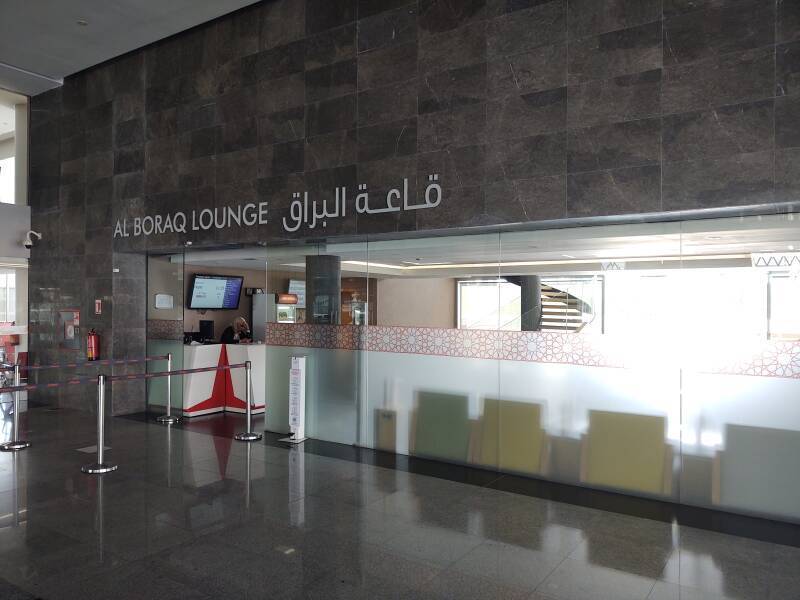
ONCF or the Office National des Chemins de Fer is the national railroad. It builds and maintains the infrastructure, and runs both passenger and freight operations.
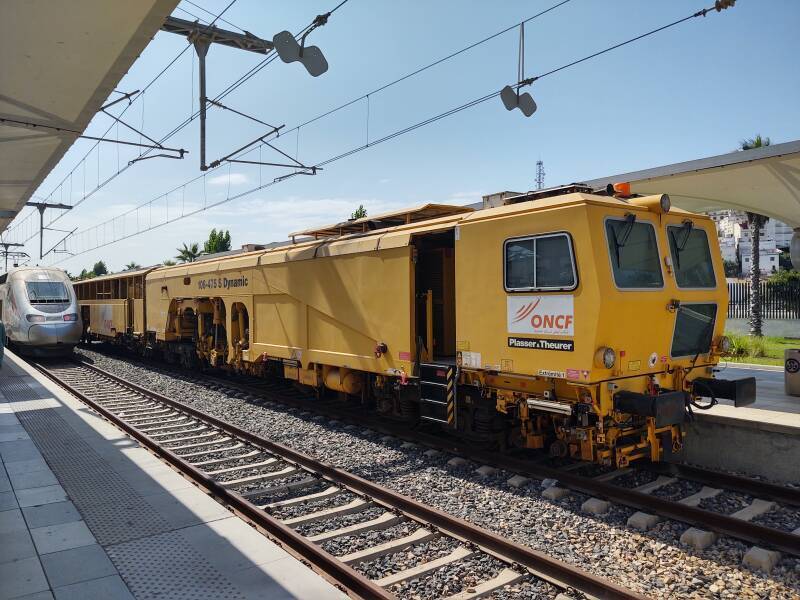
There's a total of 3,600 kilometers of rail line in Morocco, 2,200 used for passenger service and 1,300 electrified with 3 kV DC power. The two main lines are:
North-south: Tangier — Kenitra — Rabat — Casablanca — Marrakech
West-east: Kenitra — Meknès — Fès — Oujda
I have seen track maintenance going on back at home. This equipment looks much newer and more sophisticated than what we have in the U.S. But with nice fast trains you need good track.
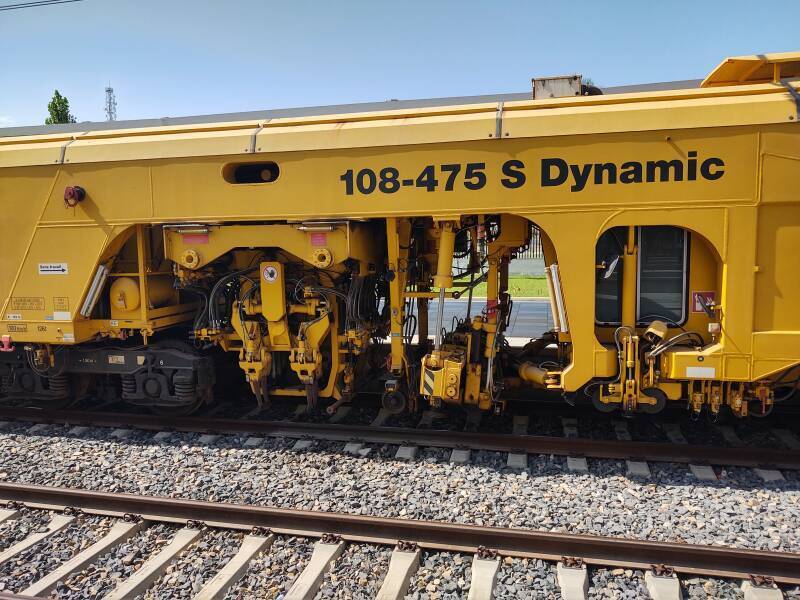
Boarding the Al Boraq
And on out the platform to the Al Boraq!
There's an engine at each end, two first-class cars, five second-class cars, and a café car.
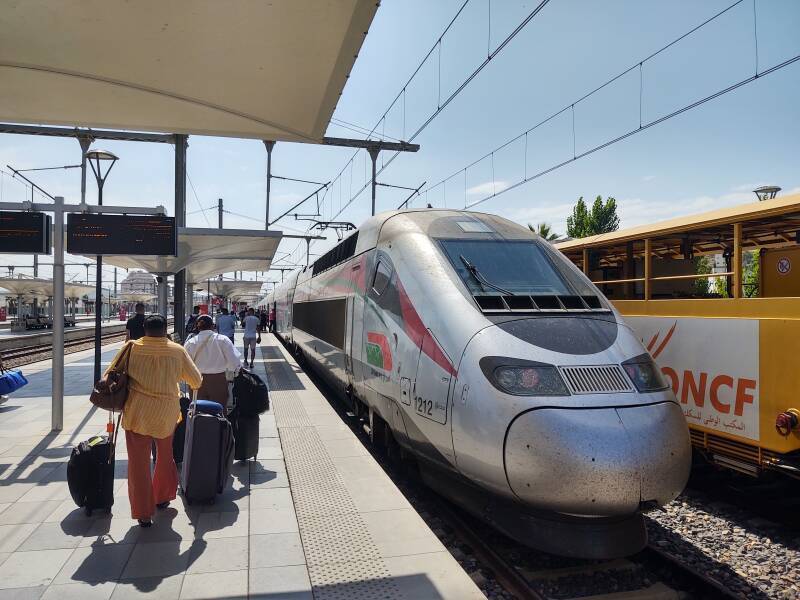
I got settled in, but not too settled in. The section between Tangier and Kenitra was specially built for high-speed service, with 25 kV 50 Hz AC power and supporting travel at 320 kilometers per hour. It would be just 50 minutes to Kenitra, and then about an hour and a half from there to Meknès.
| 1200 | Tangier | — | 1250 | Kenitra |
| 1302 | Kenitra | — | 1437 | Meknès |
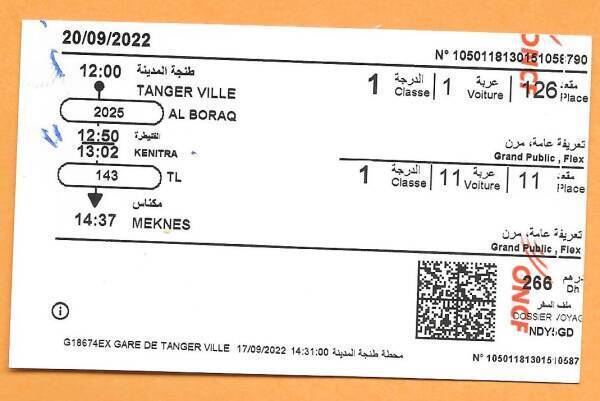
I would be getting out at Gare al Amir Abdul Kader station in Meknès as it's a little closer to my destination in the medina.
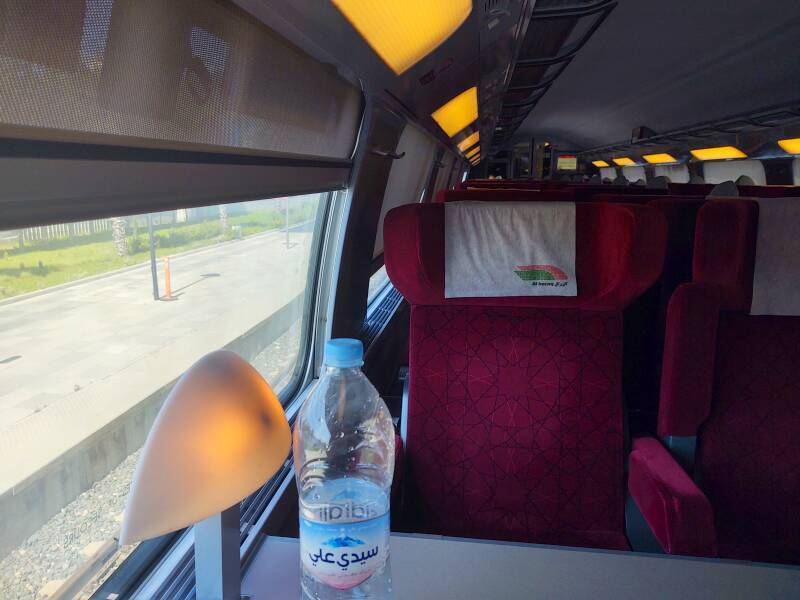
Southbound on the Al Boraq
We were soon accelerating through the Tangier suburbs. As far as I saw throughout my trip, the Al Boraq keeps a precise schedule, departing and arriving within the minute.
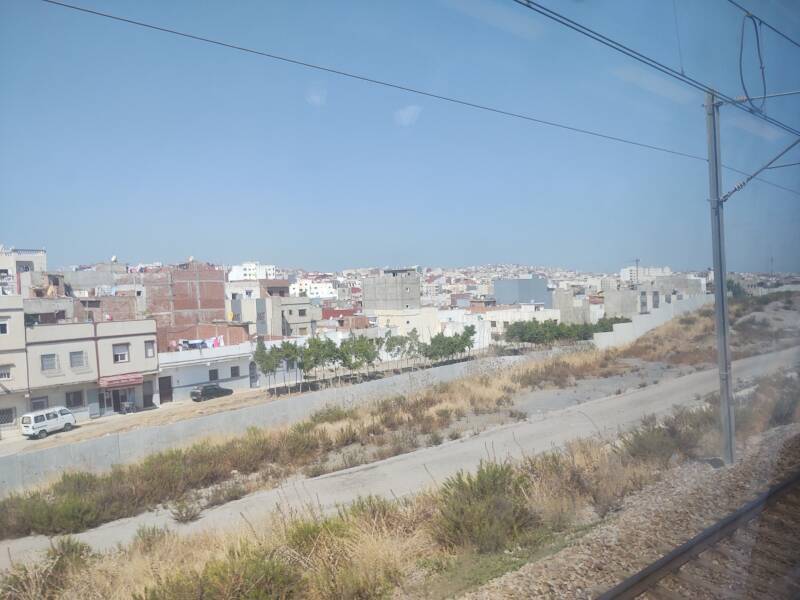
Before long we were moving at 320 kilometers per hour. I was in a window seat, facing back.
It's hard to take good pictures from on board a high-speed train. A typical digital camera scans its imaging array from top to bottom. That means that vertical objects like this pole holding up the power line lean significantly toward the left when you're looking out the right-side window with nearby objects moving rapidly from your left to your right. The top of the pole was in the middle of the frame when the camera started storing the image, but by the time it got to the bottom of the image, the bottom of the pole was right of center.
And timing your shot to not get a pole in it? While moving at 320 kph? Hah.
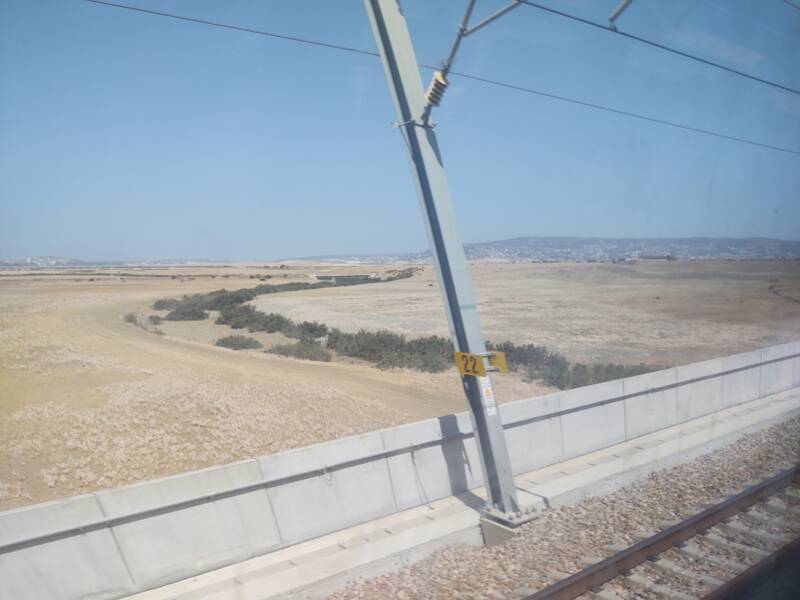
This part of Morocco is dry but not totally arid.

The coastal express highway parallels the high-speed rail line. We zipped past the traffic.
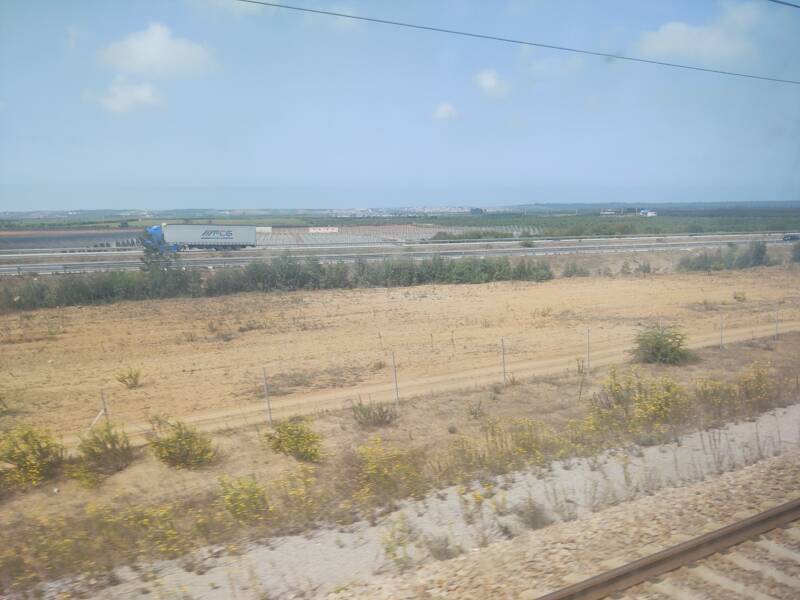
Agriculture
Morocco grows a lot of food. Some crops like wheat and barley are grown in open fields, others like olives and oranges and other fruit are grown in orchards, and some are grown under plastic sheeting.
Morocco is the world's 3rd largest producer of olives (behind Spain and Italy) and figs (behind Turkey and Egypt), 4th largest of tangerines, 15th largest of oranges and barley, and 20th largest of wheat.
Plus an enormous amount of sugar beets and spearmint for all the tea!
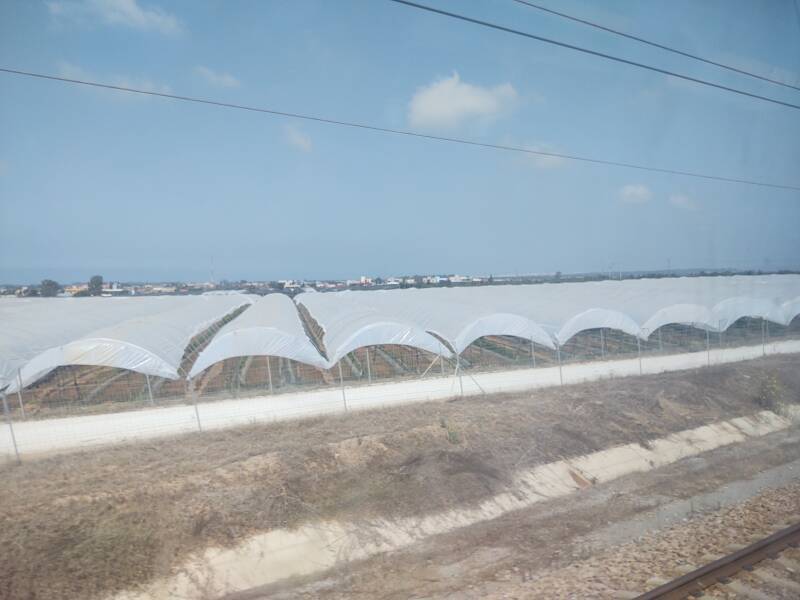

Some crops are grown under plastic sheeting laid right on the ground.
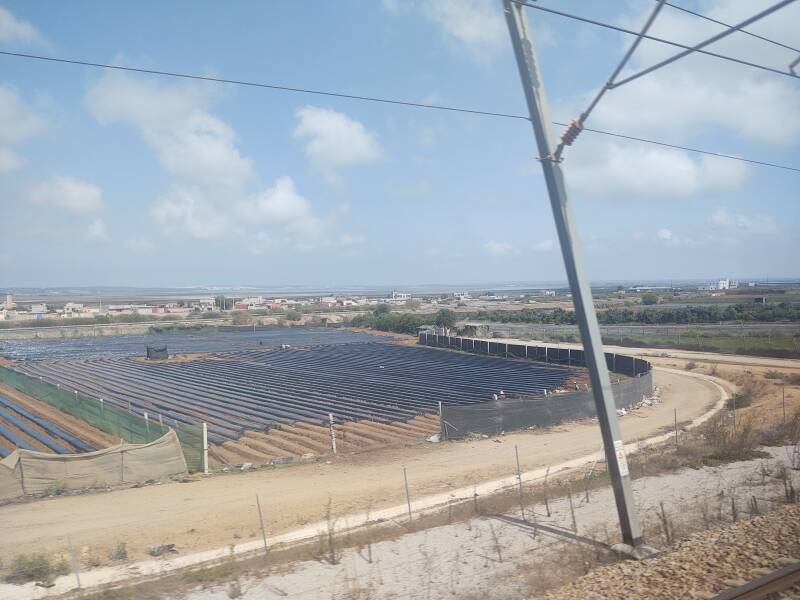
Others are grown in what I would describe as large arrays of tents.
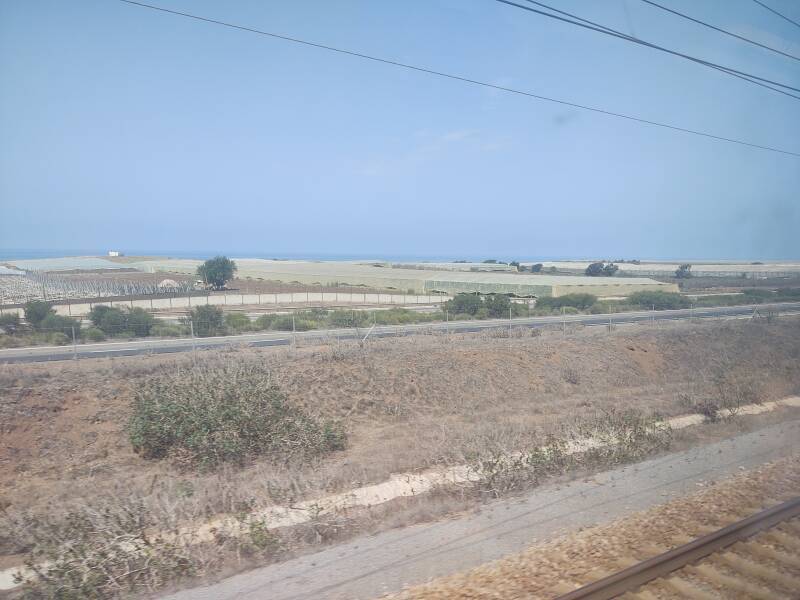
All too soon we had arrived in Kenitra and it was time to disembark.
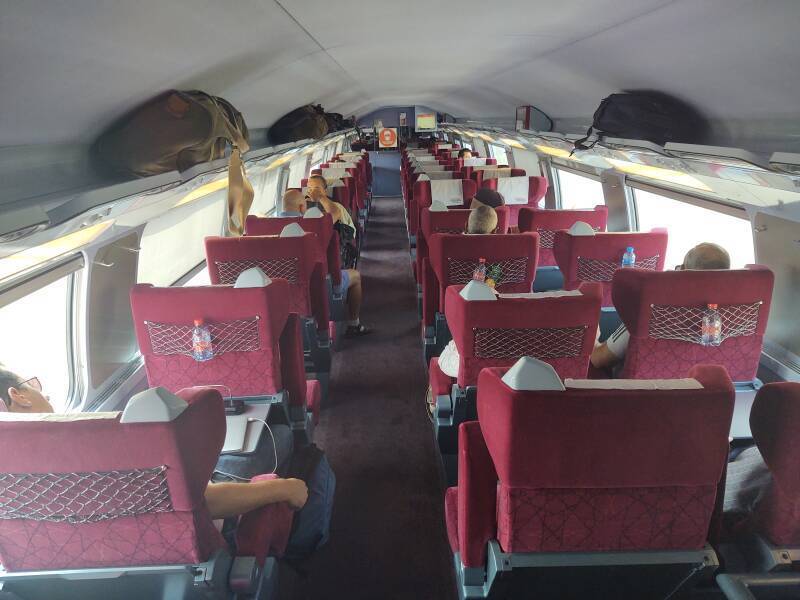
Changing Trains at Kenitra
In the below picture I have just disembarked from the Al Boraq. That's it, preparing to depart, at the right.
My next train would pull in soon just across that same platform on the left, between this platform and the orange-and-white dual-level train.
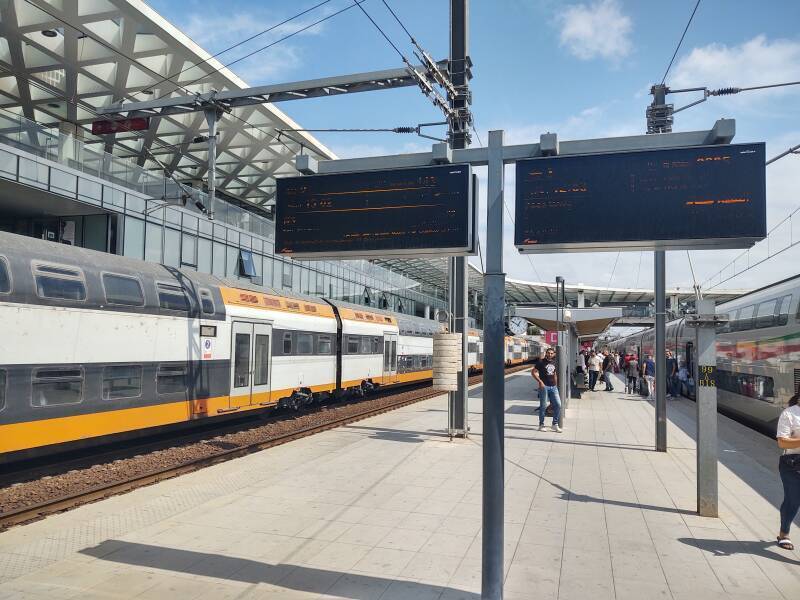
The overhead signs showed that the first-class cars would be at the rear of my next train, which seems to be the standard.
I believed that my train would be arriving from Rabat, from the direction I'm looking below. I went a little further down the platform in that direction. But I knew that I needed to pay close attention when my train was arriving — if it came in the other way, I would need to hustle down the platform toward the other end.
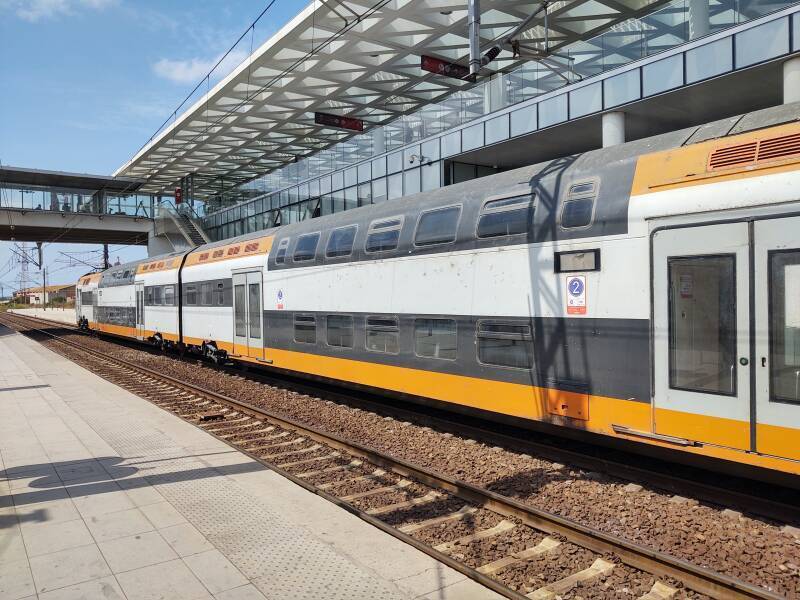
I was right! Here comes my train.
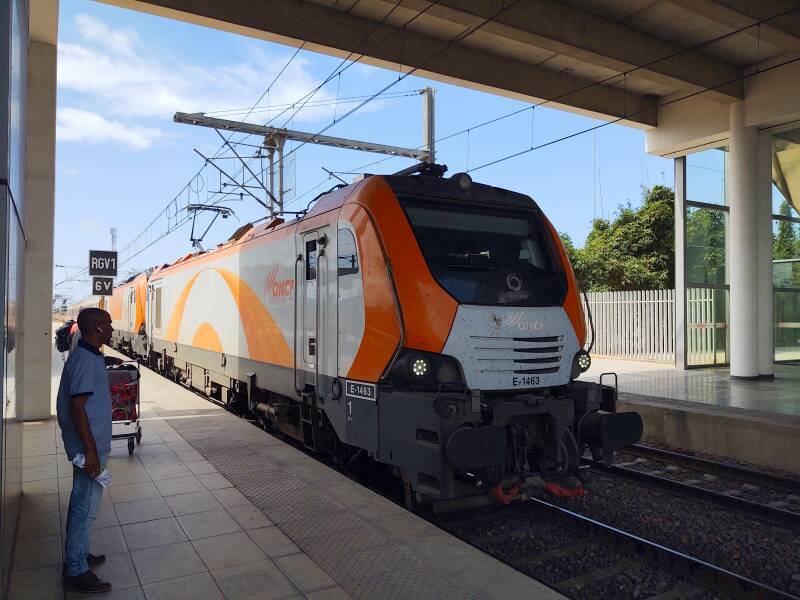
Premiere classe, voiture 11, place 11. Seat 11 in car 11, first class.
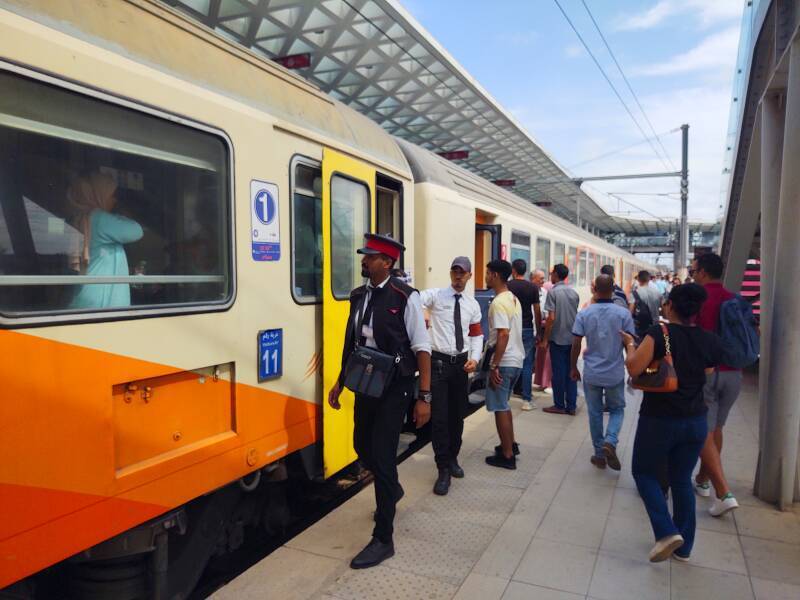
The ordinary trains have a corridor down one side with compartments holding facing bench seats.
In first class there are three seats per side with armrests that fold down. Second class compartments have four seats per side and no armrests. Both have luggage racks overhead and small bags can slide under the seats.
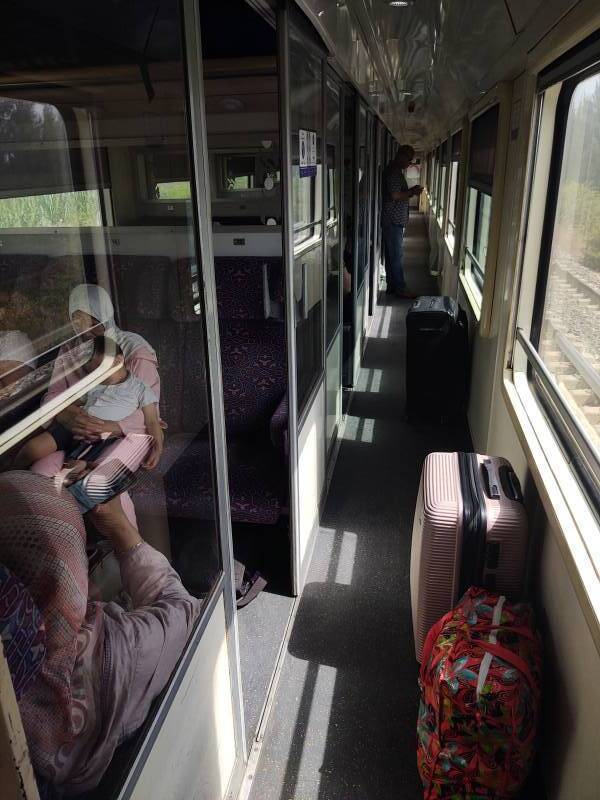
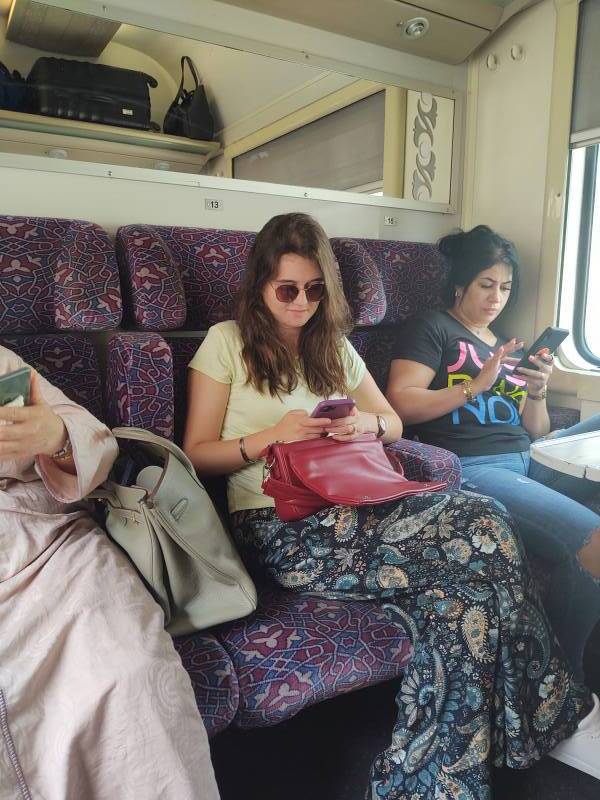
Oh my, they have assigned me a seat in a compartment with five women. But this is Morocco, it's no big deal, no one gets all worked up.
In Turkey this would be a mild scandal, and they very likely would have worked to prevent it, and possibly would move me once on board.
In Egypt, this would lead to a complete freak-out.
But this is Morocco, people are casual, there's no national contest to see who can seem the most pious.
Besides, any of them could take a break from texting to summon help on her phone.
Arriving in Meknès
There are two stations in Meknès. I got out at the first one, Gare al Amir Abdul Kader, as it was closer to where I would stay.
Is it "al Amir", "al-Amir", "el Amir", or "el-Amir"? Is it "Abdul Kader", "Abdul Kadar", "Abdulkader", or "Abdulkadar"? Yes. All sixteen combinations of those, plus others that didn't occur to me. Transliterating or transcribing Arabic for reading and pronunciation for non-Arabic speakers is a very approximate and inconsistent process.
Read the signs carefully and be flexible. But yes, this is my stop.
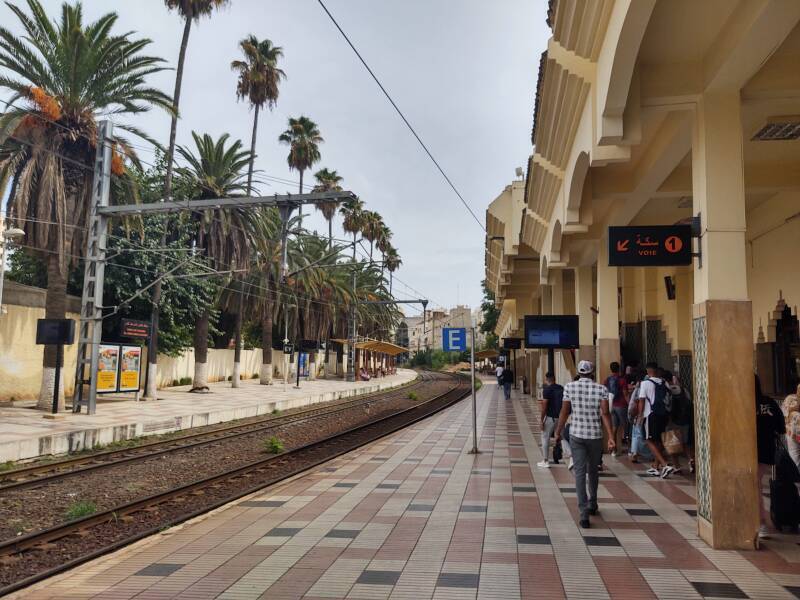
There are taxis and a swarm of taxi touts outside a typical station. This station is boxed in by other buildings on a narrow one-way street, so you are forced into the scrum.
There are grands taxis and petits taxis. The first could comfortably seat four or more people with baggage, up to six with limited baggage, and are typically used as shared taxis. Oh, you could hire a grand taxi for yourself, but you would be paying at least five times the price.
The petits taxis are smaller, seating three people comfortably with a rather limited amount of baggage. Each city has its petit taxi color scheme. In Meknès they're turquoise.
Think about it. People walking around saying "Taxi? Taxi?" are obviously talking about something that isn't a real taxi that would be allowed to wait in the taxi stand area. They're trying to get you into their personal car, or their brother's or their cousin's, parked who knows where, bound for who knows what.
"La, shukran" is the most useful Arabic phrase.
I found it useful to mutter, "La, shukran. Je veux seulement un vrai petit taxi." "No, thank you. I only want a real small taxi."
The first two drivers heard where I was going, Place el Hedim, and weren't interested. The third held up a 20 dh note, I agreed, and he said "Montez!" Get in! The equivalent of US$ 2 across town, that's a good deal.
We hadn't gone far when he saw two women with no bags looking for a cab. He pulled over and asked where they were going. It was apparently somewhere the other side of Place el Hedim.
I was in the back with my stuff. I turned my backpack to stand up on the middle of the seat and put my computer bag between my feet.
The women got in, one up front and the other in the back across from me. They were laughing and joking with the driver.
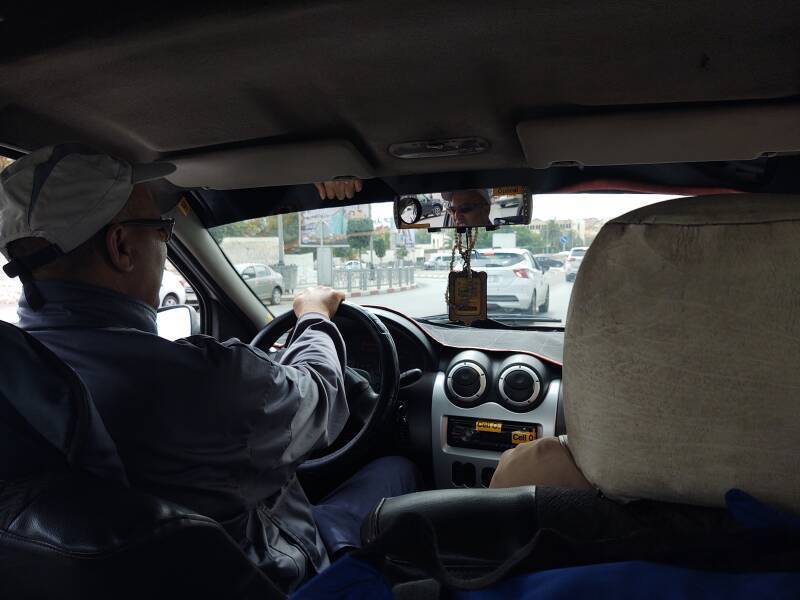
Definitely in Egypt, and very likely in Turkey, this would have required a major reconfiguration. Move my bags to the trunk and me to the front seat, and put the women together in the back. And definitely no laughing and joking or any non-essential interaction with a non-related male. But in Morocco there's far less pious obsession.
Now it was time to plunge into the medina to find the place where I would be staying.
The town and thus the station is spelled Tanger in French, their representation of the Arabic name. However, English speakers, or at least Americans, would assume that that should rhyme with "hanger".